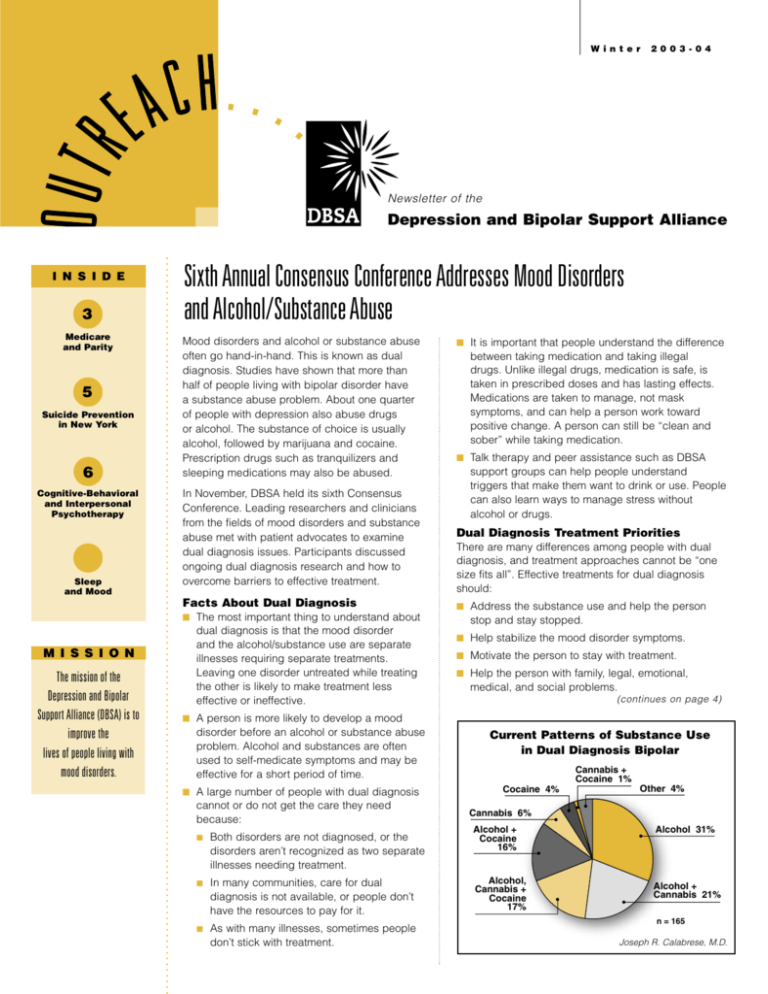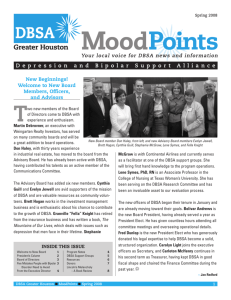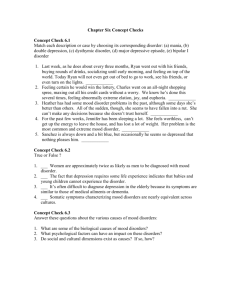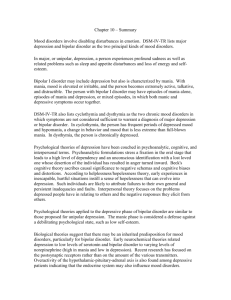
W i n t e r
2003-04
Newsletter of the
Depression and Bipolar Support Alliance
N S
S II D
D E
E
II N
3
Medicare
and Parity
5
Suicide Prevention
in New York
6
Cognitive-Behavioral
and Interpersonal
Psychotherapy
Sleep
and Mood
Sixth Annual Consensus Conference Addresses Mood Disorders
and Alcohol/Substance Abuse
Mood disorders and alcohol or substance abuse
often go hand-in-hand. This is known as dual
diagnosis. Studies have shown that more than
half of people living with bipolar disorder have
a substance abuse problem. About one quarter
of people with depression also abuse drugs
or alcohol. The substance of choice is usually
alcohol, followed by marijuana and cocaine.
Prescription drugs such as tranquilizers and
sleeping medications may also be abused.
In November, DBSA held its sixth Consensus
Conference. Leading researchers and clinicians
from the fields of mood disorders and substance
abuse met with patient advocates to examine
dual diagnosis issues. Participants discussed
ongoing dual diagnosis research and how to
overcome barriers to effective treatment.
Facts About Dual Diagnosis
■ The most important thing to understand about
dual diagnosis is that the mood disorder
and the alcohol/substance use are separate
illnesses requiring separate treatments.
Leaving one disorder untreated while treating
the other is likely to make treatment less
effective or ineffective.
M I S S I O N
The mission of the
Depression and Bipolar
Support Alliance (DBSA) is to
improve the
lives of people living with
mood disorders.
■ It is important that people understand the difference
between taking medication and taking illegal
drugs. Unlike illegal drugs, medication is safe, is
taken in prescribed doses and has lasting effects.
Medications are taken to manage, not mask
symptoms, and can help a person work toward
positive change. A person can still be “clean and
sober” while taking medication.
■ Talk therapy and peer assistance such as DBSA
support groups can help people understand
triggers that make them want to drink or use. People
can also learn ways to manage stress without
alcohol or drugs.
Dual Diagnosis Treatment Priorities
There are many differences among people with dual
diagnosis, and treatment approaches cannot be “one
size fits all”. Effective treatments for dual diagnosis
should:
■ Address the substance use and help the person
stop and stay stopped.
■ Help stabilize the mood disorder symptoms.
■ Motivate the person to stay with treatment.
■ Help the person with family, legal, emotional,
medical, and social problems.
(continues on page 4)
■ A person is more likely to develop a mood
disorder before an alcohol or substance abuse
problem. Alcohol and substances are often
used to self-medicate symptoms and may be
effective for a short period of time.
■ A large number of people with dual diagnosis
cannot or do not get the care they need
because:
disorders are not diagnosed, or the
disorders aren’t recognized as two separate
illnesses needing treatment.
■Both
■In
■As
many communities, care for dual
diagnosis is not available, or people don’t
have the resources to pay for it.
with many illnesses, sometimes people
don’t stick with treatment.
Current Patterns of Substance Use
in Dual Diagnosis Bipolar
������� ��
�������� �
������� ��
����� ��
�������� ��
������� �
�������
���
��������
�������� �
�������
���
������� ���
������� �
�������� ���
� � ���
Joseph R. Calabrese, M.D.
D B S A
President’s Outlook
N e w s
Lydia
Lewis
Steps Toward Wellness
Sometimes it can be difficult to keep a positive attitude if we feel
negativity in the world around us. When this happens, we need to
monitor our symptoms more than ever. Ask yourself: are you prone
to develop depression as the days shorten? Do you find yourself
becoming manic when you see family members? Our illnesses are
cyclical, and they often follow patterns. You are the best person to
discover your patterns, because only you know what happens to you
every day. Take a moment at the end of each day to write down a few
words about how you’re feeling. Share these with your health care
providers.
We may have been told for so long that our symptoms were “all in our
heads” that we have forgotten to listen to our bodies. In many cases,
your body will give early warning signs when an episode is coming on.
Pay attention to what your body is telling you: do you feel heavy, achy,
energetic? Sometimes we may have felt down for such a long time that
we aren’t sure what to look for as a sign we’re getting better. How can
we work toward wellness if we’ve forgotten what wellness feels like?
That’s why we need each other. In hard times, the people we meet in
our DBSA support groups remind us that we are not alone. In stable
times, we can help ourselves by reaching out and giving support to
others. Talking with people who are newly diagnosed can remind us
how far we’ve come and how important it is to stay with treatment.
People who need our help can keep us going when things look dark.
We also turn to one another for knowledge. We educate each other
about what to expect and how to get the most from our treatment.
Our doctors can learn a lot from us, too. We are the only ones that
can truly help them see our illnesses from the patient perspective.
Remember there is no right or wrong way to approach wellness.
Anything that gets you out of bed and helps you get some enjoyment
out of life without harming yourself or others can be part of your
wellness plan. Some of these things aren’t costly – taking a walk,
talking with someone, or visiting the library and researching mood
disorders or another subject that interests you.
You don’t have to do everything all at once. Wellness is a process.
Everything may not be 100% better right away, and it doesn’t have
to be. But if you do one thing – like picking up this newsletter and
reading it, you’re educating yourself and taking a step toward wellness.
Even if that’s the only thing you do today, you’ve taken one step, and
sometimes the first step the hardest of all.
2
Winter 2003-04
DBSA Outreach
“The thing that brought me to DBSA,”
Cheryl explains, “is that I was ready to kill
myself. I was dealing with my own
depression and my daughter’s bipolar
disorder. I was fighting with my doctors;
I didn’t know what was wrong. I went
online looking for a group that supported
parents and people who were
Cheryl Murphy
diagnosed.”
DBSA Southern
Nevada
Cheryl found www.DBSAlliance.org, and
with some help from DBSA staff, she
formed a group that first met in July 2002. “We had a
lot of setbacks,” she admits, “but I wasn’t about to quit –
I’m too stubborn!”
DBSA Southern Nevada’s biggest challenge was finding
a permanent place to meet. After several changes of
venue due to rules and politics beyond their control,
they lost their meeting space in September 2003. A
local TV station heard about their struggle and did an
interview, which led to a lengthy article in the Las Vegas
Mercury. The article got an enormous response, and by
November, DBSA Southern Nevada had eight meetings
throughout Las Vegas and one each in North Las Vegas
and Henderson. They now hold four meetings on the
same night: mood disorders, dual diagnosis, parents
and adolescents. There is also a website
that provides three
weekly chat rooms for people who can’t get to meetings.
“We are a team,” Cheryl says. “It’s about watching
people grow and get better. Recently a man came in –
he was a mess. He had lost his job – we were all worried
about him. But he kept coming to meetings no matter
what. Today he’s sitting tall, smiling, joking, you can see
the radiance in his face. It’s hard to believe he’s the
same man. It’s just amazing to watch people change.
And it’s all because of the support group.”
Cheryl has been in 12-step recovery for more than 20
years. “I learned you have to give it away to keep it,” she
explains. “The rewards come when you can show
someone that there is hope – there is a place for them to
go and people to talk to who will understand. People
need the opportunity to learn from others, so their road
will be a little easier than the ones who have gone before.
We help provide that opportunity.”
“We reach out to others because we have been there, we
care, we understand and we can help. I am so thankful
to DBSA for saving my life and my daughter’s life, and
for giving me the opportunity to help others in their
search for information and support. Together we can
make a difference, one person at a time.”
f r om t he
Letter
Chair
William P.
Ashdown
As 2004 begins, we can look
back at 2003 with pride and
satisfaction. DBSA touched more
than three million people with
our support groups, educational
materials and media outreach.
People who were lost now have a
place to turn.
DBSA has been here to help
when people needed it most
– when they were afraid, ashamed
or alone. We have been here for people who
thought they might have a mood disorder, for
those just diagnosed, and for those who were
frustrated by treatment trial-and-errors. We
have also been here for families, whether or
not their loved ones received treatment. DBSA
group members have shed light on loved ones’
illnesses, and listened with compassion and
understanding.
In DBSA support groups we’ve realized that
our illnesses do not define who we are. Each
of us is so much more. We all have unique
talents and gifts – maybe they’ve been
neglected or forgotten when we became ill.
But they are there, waiting to be rediscovered.
Now and in the future, you can have faith that
DBSA will be here for you. Faith can be the
most powerful force of all, the one thing we
can hang on to when our challenges seem
insurmountable. When things look bleak,
know that things will change. Your mood will
change; your situation will change; and the
treatments available will change. Embrace the
change when it happens, even if it isn’t what
you expected. Have faith in yourself, in DBSA
and in the treatments for your illness. Stick with
your treatment even when you don’t want to.
Know that there is always hope, and that you
can feel better.
DBSA
2003
Board of
Directors
EXECUTIV E C O M M I T T E E
Chair
William P. Ashdown
Winnipeg, Manitoba, Canada
Vice Chair
James C. Swinney
Grapevine, Texas
Secretary
Dorene Sherman, M.A.
Toledo, Ohio
Treasurer
Susan Silverman, M.B.A.
Highland Park, Illinois
Chair, Scientific Advisory Board
Dennis S. Charney, M.D.
Bethesda, Maryland
Watching Washington
Congress Makes Sweeping Changes
to Medicare
Legislation adding prescription drug coverage to
Medicare passed Congress at the end of 2003.
From 2006 to 2016, $400 billion will be spent on
prescription drug coverage for people who are over
65 or have a disability. The plan also encourages
private health plans to compete with Medicare. The
new prescription medication program will require
people to pay a monthly premium beginning in 2006.
It will have a $250 deductible and a 25 percent
co-payment for medication costs greater than $250,
up to an initial coverage limit of $2,250. After the
$2,250 limit, the person will have no benefit (other
than medication discounts) until the out-of-pocket
expenses are over $3,600. Beyond $3,600, 95 to 100
percent of the costs will be covered, depending on
the person’s income.
Critics of the legislation said its benefits were not
broad enough to cover rising medication prices.
Supporters said it is a good start toward providing
assistance for prescription costs.
Congress will discuss other Medicare legislation
in late January 2004. The Medicare Mental Health
Copayment Equity Act (S. 853) would gradually
reduce the mental health care co-payment from
50 to 20 percent. The Medicare Mental Health
Modernization Act of 2003 (S. 646) would further
improve Medicare’s mental health services.
Member-at-Large
Daniel J. Conti, Ph.D.
Clarendon Hills, Illinois
Parity Stalls for Another Year
Legislation requiring insurance parity for mental
illnesses (S. 486, H.R. 953) has again stalled in
Congress. However, Senate Republican leaders
agreed to consider the legislation early in 2004.
In the meantime, Congress has extended
existing legislation through the end of 2004.
It re-authorizes a current law that requires
employer-provided insurance plans to make
lifetime limits on mental health benefits equal
to those on medical and surgical benefits. The
law does not, however, require companies to
provide full mental health coverage. Parity
supporters, chief among them Senators
Pete Domenici (R-NM) and Ted Kennedy
(D-MA), secured an agreement from the Senate
leadership to bring the bill to the Senate floor
early next year. In the House, where Speaker
Dennis Hastert (R-IL) has blocked the bill, its
future is uncertain.
It is important that you voice your support of
parity to Speaker Hastert (R-IL), Senate Majority
Leader Bill Frist (R-TN), and your own
Representatives and Senators. For help, visit
www.DBSAlliance.org and click on the
“Advocacy/Legislative Action Center” link,
or call the U.S. Capitol Switchboard at
(202) 224-3121.
Member-at-Large
Thomas L. Schwenk, M.D.
Ann Arbor, Michigan
DIRECTO R S
John R. Bush
Austin, Texas
Larry Fricks
Atlanta, Georgia
Cheryl Gidley, M.B.A.
Tower Lakes, Illinois
J. Maurits Hudig
Montclair, New Jersey
Adrian M. Mosley, M.S.W.,
L.S.W.-C.
Owings Mills, Maryland
Stephen Propst, M.B.A.
Atlanta, Georgia
Randy Revelle, J.D.
Seattle, Washington
Polly D. Sherard
Bethesda, Maryland
PRESIDEN T
Lydia Lewis
Chicago, Illinois
Winter 2003-04
DBSA Outreach
3
D B S A
N e w s
Celebrate 2004 with the Gift of DBSA
A great deal of progress in mood
disorder treatments has occurred in
recent decades. New medications to
Dennis Charney, M.D.
treat mania and depression have been
discovered. New psychotherapies have been developed. We
have a greater understanding of the benefits of peer support.
We also have new knowledge about the genetics of mood
disorders.
We have come a long way from treatments like insulin shock,
amphetamines and psychoanalytic theory. Today we are seeking
novel treatments that are safe, effective and free of side effects.
Trials to test the effectiveness of treatments such as vagus nerve
stimulation and repetitive transcranial magnetic stimulation
continue. There are fresh perspectives on existing treatment
methods in discussion as well. We know much more about the
brain today, but still have great deal to learn.
At least 3.5 million people with depression or bipolar disorder
are not being treated to full wellness. Studies by Robert M. Post,
M.D., estimate that at least 40 percent of people in the U.S. with
bipolar disorder are not in treatment at all. It is extremely
important that we all strive to educate the public with our new
knowledge. If people are educated, they will be able to
recognize the symptoms of depression and mania earlier and
look for treatment in spite of shame or fear.
Today we can observe the formation of new brain cells in
laboratory animals treated with antidepressants. We can study
the genes that make people more likely to develop mood
disorders in response to stress. New brain chemicals that may
be related to mood disorders are being discovered. Treatment
methods for imbalances in these chemicals are being
developed.
Today’s methods of diagnosis help us treat many people who
were ineffectively treated several years ago. Thoughts, emotions
and day-to-day activities affect the chemical makeup of the brain
in ways we are just learning. Better approaches, both medical
and psychotherapeutic, are evolving to treat these illnesses early
and aggressively.
Mood disorders are the result of many different factors. Genetic
vulnerability, traumatic experiences, environmental factors and
chemical changes within the brain all contribute to mood
disorders. With this knowledge, we can encourage families to get
treatment for at-risk members, and possibly avoid future crises.
Many of the treatments being studied today are years away from
clinical use. The time and effort spent in development ensures
that these treatments are safe and effective. Through careful
study, clinical trials, widespread education, and communication
among professionals and patients, we can continue to find ways
to lift depression, stabilize mania, and help future generations
lead productive lives.
4
Winter 2003-04
DBSA Outreach
DBSA brings you a unique opportunity to wish friends a
healthy 2004 and share your hope with those you love.
Even if you missed the holidays, these timeless, all-season
gifts can show someone you’re thinking of them throughout
the year. Your gift also helps improve the lives of people
living with mood disorders.
What better way to make someone feel special than by
helping others in their name? A gift donation to DBSA will
help provide education and support to millions of people.
It’s a perfect way to celebrate any special occasion.
For a minimum $25.00 donation per gift, DBSA will
send the recipient one of our signature quilt notecards
announcing your thoughtful donation. The notecard
will include your name and if you wish, a personalized
message, but not the donation amount.
If you prefer, gift announcement notecards can be sent
directly to you. You’ll receive an acknowledgement
of your donation for tax purposes. DBSA is a not-forprofit, 501(c)(3) Illinois corporation and all donations are
deductible based on IRS regulations.
Make someone feel special by providing mood disorder
education and support in their name. On behalf of those
we serve, DBSA thanks you for your support.
Sixth Annual Consensus Conference
(continued from page 1)
Communication is especially important in dual diagnosis
treatment. Patients need to be honest about their alcohol
and substance use when talking with professionals.
Professionals need to be sensitive to cultural differences
among patients.
The impact of dual diagnosis is just beginning to be
understood. Unfortunately, many treatment trials currently
exclude people who abuse alcohol or drugs. Researchers
need to develop more clinical trials that include people
with dual diagnosis and gather information about their
response to treatment.
In the coming months, DBSA will develop a consensus
statement to summarize the conference findings. It
will also call attention to the urgent need for increased
research, further-reaching education and more effective
treatments.
C h a p t e r
New York Chapters Unite at
Suicide Prevention Event
DBSA Rochester hosted a very successful
weekend event, which included a wellattended facilitator orientation and the first
state-wide chapter leader meeting.
Attendees discussed forming New York
State DBSA, and a member of New
Jersey State DBSA shared his experience.
Featured speakers included facilitator
trainer Chuck Weinstein, M.A.E, suicide
prevention writer Susan Rose Blauner, and
policeman and activist Eric Weaver.
Participants talked about support,
leadership and advocacy, and signed
letters encouraging state legislators to
adopt Timothy’s Law, which would require
insurance parity throughout New York.
H i g h l i g h t s
Members have also been writing letters,
making phone calls and contacting
politicians in an effort to prevent the closing
of the Canandaigua Veterans’ Administration
Hospital, where the event was held. Sunday
morning’s suicide prevention breakfast was
open to the public and covered by four
television stations.
For more information: Rita Cronise at (585)
924-7936 or DBSACanandaigua@aol.com.
Metro Detroit Writers Publish
Words to Heal and Inspire
DBSA Metro Detroit has published an
anthology of poetry and prose, The Other
Side of Darkness, edited by Gil Saenz and
Jacqueline Castine, the product of two
years of writing workshop sessions. The
book was created to showcase the work of
support group members and to demonstrate
The Power Within
“If I gave you my entire psychiatric history,”
Ken says, “you’d probably wonder how
I could put two sentences together and
function on any meaningful level. During
tough times, I look back and see only the
darkness, but there has been a lot of light,
otherwise I wouldn’t have survived.”
Ken, a scientific publishing executive,
was president of DBSA Boston (previously
MDDA) in 1997. He began attending the
support group in 1989 and subsequently
served as a group facilitator, chief
facilitator and board member. He began
fighting depression early. At a young age,
he witnessed his mother being killed by his
father, who was found not guilty by reason
of insanity. Later, he had a family of his
own, and his first son died of a treatable
illness, largely due to physician errors.
Ken tried everything to treat his
depression. “Years of talk therapy,
medication of every size, shape and
color, moving across the country, climbing
mountains, being constantly busy, trying
to build a relationship with my father. All
the things I accomplished were worth a
lot, but they meant nothing to me at the
time because I couldn’t get rid of the
depression. Today the outside world hasn’t
changed, but my internal perspective has.
I’m learning to look at things differently.”
Ken credits much of his turnaround to a
doctor he began working with three years
ago. After briefly discussing medication, to
Ken’s surprise, this psychopharmacologist,
trained to prescribe medications, began
explaining the process of finding peace of
mind.
Overcoming depression, for Ken, involved
a spiritual approach. By trying to control
his own emotions, he found that he only
allowed them to control him. When he gave
up control and used that energy to follow
his own creative path, he was better able
to cope with the emotions and get through
each day.
“My depression hasn’t changed,” he
explains, “but my reaction to it has.” He
uses the analogy of encountering a bear
in the forest: your gut reaction is to run,
that stability can come from suffering.
More than 30 writers – some never before
published, some published many times
– contributed to the book, giving it a wide
range of perspectives and emotions.
The book’s introduction states, “The
ability to sit down and write about one’s
experiences is a sign of detachment and
of a healthy attitude. Not only is it many
times therapeutic, but it also may provide
important insights into a person’s thoughts
and feelings before, during and/or after
that person experiences illness.”
Copies can be obtained for $20.00 +
$3.50 shipping and handling. For more
information: Mary Ann Bozenski at
(734) 284-5563 or lifeinbalance@mddametro-detroit.org.
Ken Heideman
DBSA Boston, MA
but you have the best chance if you lie
down and act as if you’re totally relaxed.
Similarly, it’s difficult to outrun one’s own
emotions. Another apt comparison is
quicksand. Ken says, “the more I wiggle,
the faster I sink, so I’m learning to stop
wiggling.”
Since he began working with this doctor,
who believed in him and encouraged him,
Ken has written and recorded several
songs and is continuing his musical
pursuits. Today he lives in the present.
“I’ve grown a lot through my illness and
have a lot to show for it, if I stay in the
present. Don’t regret the past,” he says,
“because everything you’ve experienced,
good and bad, got you where you are
now, which is on the verge of creating the
kind of life you’ve always wanted. Have
gratitude, have patience, get in touch with
who you are and go for what you want
now! Give yourself credit for the person
you have become. The real power for all of
us lies in within ourselves. Tapping into that
power is exhilarating and a bit scary. But
by all means, enjoy the ride!”
Winter 2003-04
DBSA Outreach
5
Research & Treatment
Improving Cultural Understanding
Robert L. Johnson, MD, FAAP
SAB member, Professor of Pediatrics and Psychiatry
Director, Division of Adolescent and Young Adult Medicine
Interim Chair, Department of Pediatrics
UMDNJ - New Jersey Medical School
Culture is the behavior pattern of a racial,
ethnic, religious or social group. It includes
thoughts, communications, actions,
customs, beliefs and values. It is the
result of a person’s racial/ethnic makeup,
birthplace, homes and friends. Education,
work and everyday life experience also
influence culture.
Culture has a large impact on health
care. Patients may not receive adequate
care if providers do not consider their
cultural needs. This is particularly true with
mental health care, which relies heavily
on communication. Mental health services
must be sensitive to culture. Verbal and
written communication must be easy to
understand regardless of a person’s first
language or education level.
Improving Cultural Competence
If providers and patients cannot relate
to one another on a cultural level,
patients may be less likely to participate
in treatment. They may also be less
responsive. Providers must keep several
key cultural differences in mind.
Communication differences: Providers
must be aware of the potential for
miscommunication. Culturally-linked
Robert L. Johnson,
MD, FAAP
behavior styles such as body language
and eye contact may affect communication.
Some cultural groups may also become
anxious in the presence of “expert”
providers.
Literacy differences: Educational materials
must be easy to understand. This is
especially important when medication
directions or dosages are involved.
Providers may need to make extra effort if
the patient’s first language is not English.
Attitude differences: Different cultures
have different attitudes toward diet,
exercise, smoking, drinking, body image
and mental health. These differences
may affect the way patients report
their symptoms. They also may make
patients more or less likely to stick with
treatment. Providers must make an effort
to understand these attitudes and make
changes as needed.
Physical differences: Patients from some
ethnic groups may also face special health
challenges. Medication metabolism varies
among ethnic groups. This may make a
difference in treatment effectiveness. Some
ethnic groups may also have unexpected
side effects, especially from mental health
medications.
What Patients and Families
Can Do
If possible, patients and their families
should communicate their beliefs about
mental illness to providers. They should
discuss previous personal or family
experiences and things they have heard in
the media. Patients can also let providers
know the type of help they need. This may
include easy-to-read materials, materials
in their native language, or treatment that
takes their religious beliefs into account.
It’s also helpful for patients to share the
things they expect from treatment. This
may include relief of symptoms, assistance
with family difficulties, or help stopping
drinking or using drugs. Having these
discussions early in treatment can improve
communication and make providers more
aware of cultural differences.
Patients of all cultures share needs, fears
and hopes. Providers have concern for
patients and interest in seeing their health
improve. When patients and providers
work together to bridge cultural gaps, they
can build a cooperative and productive
treatment process.
Treating Mood Disorders with Interpersonal and Cognitive-Behavioral Psychotherapy
Psychotherapy (talk therapy) has
been a useful tool to treat depression and
bipolar disorder for decades. For some
people, it can work well alone; for others,
a combination of medication, talk therapy
and peer support works best. There
are many theories about what a person
needs to become well and the type of
psychotherapy that is most appropriate.
Most psychotherapists use a combination
of types, and different approaches work
better for different people.
Interpersonal therapy (IPT) and cognitivebehavioral therapy (CBT) go beyond
6
Winter 2003-04
DBSA Outreach
conversation, support and insight to
help people change the way they relate,
think and act. These therapies have
been shown to yield good results when
treating mood disorders.
Interpersonal therapy was originally
developed to treat depression. It has
since been adapted for bipolar and
other disorders. It is time-limited and
goal-oriented, and addresses a person’s
symptoms, social relationships and roles.
IPT focuses on what is happening “here
and now” and attempts to help a person
change, rather than just understand,
his or her actions and reactions. The
patient and therapist examine current
relationships and relationships that have
recently been lost. IPT does not focus on
unconscious or subconscious motivations,
wishes or dreams. It looks at conscious,
outward action and social adaptation. It
does not try to change the personality,
but it may help teach new skills that can
lessen some personality disorders.
An IPT therapist is an active supporter of
the patient on the wellness journey. The
therapist does not assign homework, but
may encourage a person to engage in
social activities.
(continues next page)
A
Ellen Frank, Ph.D.: Sleep loss can be
a trigger for mania. However, if patients
and family members keep a close watch
on moods and stay on the lookout for
manic symptoms, episodes can be
prevented or their severity can
be decreased.
Sleep loss can be preceded by
disruptions in a person’s social rhythms.
These disruptions may be associated
with serious life events, such as coping
with a death in the family or spending
the night caring for a very sick child.
They may also be caused by less serious
events like staying up much of night
to watch a movie or finish housework.
The stress level of the event does not
necessarily indicate whether a person will
the Docto
r
s
Question: How do the length of sleep
time and regularity of the sleep schedule
affect manic and depressive episodes?
Can they be triggers?
sk
become manic or how severe the mania
will be.
People with bipolar disorder often have
internal clocks that are easily thrown offbalance. This makes traveling across time
zones or changing one’s work schedule
potentially risky. If a person’s clock is
thrown off-balance and he or she is
deprived of the usual amount of sleep, this
can lead to mania.
It’s also important to keep in mind that
different people have different needs for
sleep. Find out the ideal amount of sleep
that you or your loved one need(s) and
try to stick to it. If you find you need much
more or much less sleep than usual,
this may actually be a sign of a manic
or depressive episode. If this continues
for more than a couple of days, call your
health care professional so you can take
steps to stabilize your mood before the
episode becomes serious.
A regular sleep schedule helps improve
the quality of your sleep and how
restful it is. Keep in mind that waking
up at the same time each day (even
on weekends) is more important than
going to bed at the same time, though
you should do your best to keep both
constant. If for some reason, you need
to change your sleep schedule, do
it gradually. Don’t try to change your
going to sleep time or your waking up
time by more than 15 minutes per day.
Dr. Frank is Professor of Psychiatry
and Psychology at the University of
Pittsburgh School of Medicine, and a
member of DBSA’s Scientific Advisory
Board.
Information in “Ask the Doctors”
is not meant to take the place of a
consultation with a qualified health
care provider.
Interpersonal and Cognitive-Behavioral Psychotherapy (continued from page 6)
The IPT therapist helps the patient
review his or her symptoms and relate
these symptoms to one of four things.
Symptoms may be the result of unresolved
grief over a loss, interpersonal role
disputes (conflicts with others), role
transitions (changes in life status such as
moving or changing jobs) or interpersonal
deficits (isolation or lack of social skills).
Next, the therapist and the patient work
through the specific situations, one by
one, to relieve symptoms and stress.
them. Automatic thoughts may include
focusing on one negative detail (an
unkind person) and applying the negative
quality to everything (the human race in
general); perceiving things as “all good”
or “all bad”; or applying labels such as
“loser,” “no good,” or “worthless.” Core
beliefs may include, “I have to succeed at
everything and everyone has to love me,”
“It’s a disaster if things don’t go the way
I plan or expect,” or “I can’t change the
miserable way I am.”
Cognitive-behavioral therapy combines
cognitive therapy, which involves
examining how a person’s thoughts affect
the emotions, and behavioral therapy,
which involves changing a person’s
reactions to challenging situations. CBT
is goal-oriented and works best when the
patient takes an active role.
The behavioral aspect of CBT takes place
after a person has a more calm state of
mind. The person can then take actions
that help him or her move closer to
planned goals. For example, if depression
has caused someone to withdraw from
life, that person may be encouraged
to participate in hobbies or spend time
with friends. Or a person may be gently
coached, under supervision, to confront
situations, things or people that cause
fear or panic. Through practice, a person
learns new, healthier behaviors.
The cognitive aspect of CBT helps a
person recognize the automatic thoughts
or core beliefs that contribute to negative
emotions. Next, the therapist helps the
person see that some of these thoughts
and beliefs are false or don’t make sense.
Then the person is guided to change
With CBT, the therapist assigns homework.
It may include journaling, reviewing notes
or tapes of the therapy session, or trying
a new approach to an old problem.
There may also be exercises to make
a person more aware of his or her own
thoughts and actions without judging
them.
The most important parts of any type of
therapy are partnership, communication,
collaboration and trust. When choosing
a therapist, a person should feel
safe and have faith in the therapist’s
judgment. Goals and methods should
be discussed at the beginning of
therapy so the patient knows what to
expect and how to measure progress.
Successful therapy can help a person
change thoughts, beliefs, perceptions
and actions for the better.
For a helpful tool in your
search for a therapist, order a
free copy of DBSA’s Finding
a Mental Health Professional
brochure, or download it at
www.DBSAlliance.org/PDF/
finding.pdf.
Winter 2003-04
DBSA Outreach
7
DBSA
730 N. Franklin Street, Suite 501
Chicago, IL USA 60610-7224
(800) 826-3632
Fax (312) 642-7243
www.DBSAlliance.org
DBSA Outreach is a quarterly
publication serving supporters and
constituents of the organization.
DBSA does not endorse or recommend
the use of any specific treatment or
medication. For advice about specific
treatments or medications, patients should
consult their health care providers.
Change of address?
Call us at (800) 826-3632 or e-mail
mailing@DBSAlliance.org
Non-Profit Organization
U.S. Postage
P A I D
Chicago, IL
Permit No. 8331
Questions?
Call us or e-mail
questions@DBSAlliance.org
D
ER
S H I P CI
R
CL
E
LEA
Editor: Laura Hoofnagle
..
..
..
.....
..
.
2003
..
.....
..
...
.
ABBOTT LABORATORIES
ASTRAZENECA PHARMACEUTICALS
BRISTOL-MYERS SQUIBB COMPANY
ELAN PHARMACEUTICALS
ELI LILLY AND COMPANY
JANSSEN PHARMACEUTICA PRODUCTS
PFIZER INC
DBSAacknowledgesIts2003
LeadershipCircle;organizations
thatcommittedaminimumof$150,000
totheassociationduring2003.
printed on recycled paper using vegetable-based inks.
©2004 DBSA. All rights reserved.
Statements of fact or opinion are the
responsibility of the authors and do not
necessarily imply an opinion of DBSA or
its officers or supporters. Articles
may be reprinted with attribution:
“Outreach, Winter 2003-04, DBSA.
All rights reserved.”
Yes, I want to make a difference. Enclosed is my gift of:
■$500 Gold ■$150 Silver ■$50 Bronze ■$20 Member ■Other $ ____________
Support DBSA!
Name ___________________________________________________________________________________________________________
Just your gift alone will make a
difference. Your gift alone will
change a life. Contribute to
DBSA by using this form,
call us at (800) 826-3632 or
visit our secure website at
www.DBSAlliance.org.
All information provided is held
in strict confidence. If you have
any questions, please call
(800) 826-3632 or (312) 642-0049.
Thank you for your gift!
Address _______________________________________________________________City______________________________________
State/Province ____________________________Country ______________________________ Zip/Postal Code __________________
Daytime Telephone ________________________________ E-mail ________________________________________________________
■ Check (payable to DBSA) ■ Money order ■ Mastercard ■ Visa ■ Discover ■ American Express
Account Number _____________________________________________ Exp. Date ________________
Signature_____________________________________________________
■ I’d like details on including DBSA in my will.
■ I wish my gift to remain anonymous.
■ I have enclosed my company’s matching gift form.
■ Please send me more information on mood disorders.
■ Please send me _____ donation envelopes to share.
■ Please send all correspondence in a confidential envelope.
If you would like to make your gift a Memorial or Honorary tribute, please complete the following:
Please check 0581 to
support DBSA through the
Combined Federal Campaign or
Community Health Charities.
Please visit www.igive.com
to support DBSA when
you shop online.
■ In memory of / In honor of (circle one)____________________________________________________________________________
■ Please send an acknowledgment of my gift to:
DBSA is a not-for-profit, 501(c)(3)
Illinois corporation. All donations
are deductible based on federal
Address ______________________________________________________________________ IRS regulations. Please consult
your tax advisor for details. All
City, State, Zip _________________________________________________________________ information provided is held in
strict confidence and at no time
will be shared with, sold or rented
Please send this form and payment, using the envelope in the center of Outreach, to:
to other organizations. [OUT-W0304]
Name ________________________________________________________________________
DBSA, 730 N. Franklin St., Suite 501, Chicago, IL 60610-7224 USA.
Credit card payments may be faxed to (312) 642-7243.












